What's the Structural Integrity of Garbage?
I've received a lot of shipments over the pandemic. The boxes can be broken down flat, but they're in truth not that easy to rip apart or fit into a garbage or recycling can. I've thought about burning them. But, all this gently-used cardboard I'm sitting on represents a resource that's obviously being underutilized.
One of my distant inspirations was this video for turning cardboard into rigid structural parts. This is fascinating, but since the molds are 3D printed, this means you can only make things that are smaller than a 3D printer bed by some margin. I'm looking for a way to turn the many big, flat boxes I have into something like poor man's plywood.
My idea to put this cardboard to good use resulted in this experiment I call "plycard": layers of cut cardboard boxes wood glued to popsicle sticks in alternating layers.
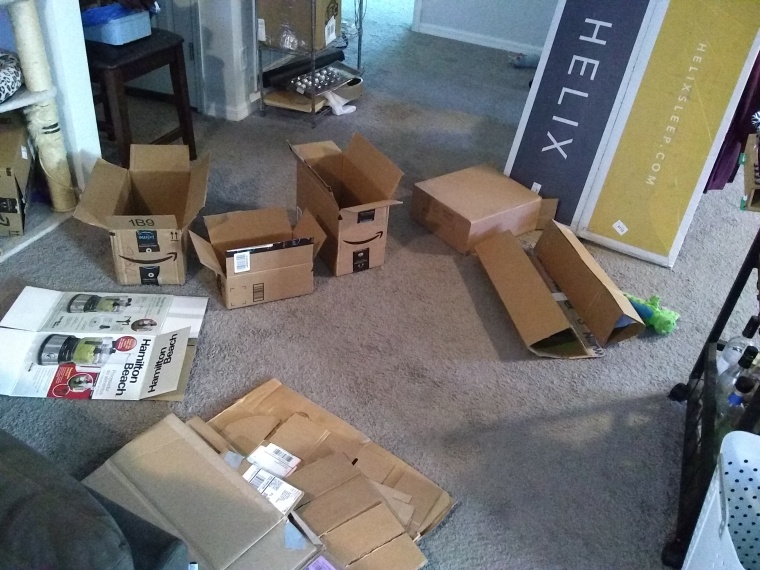 January 9th, 2021: I've selected some subjects. My intention was to make some plycard samples made from different grades of cardboard. There's glossy stuff that feels quite rigid, thin raggedy stuff that's usually not shipped on its own, the "decent" stuff like brand new Amazon boxes, and some amazing stuff that's practically wood already, like the box my Helix mattress came in.
January 9th, 2021: I've selected some subjects. My intention was to make some plycard samples made from different grades of cardboard. There's glossy stuff that feels quite rigid, thin raggedy stuff that's usually not shipped on its own, the "decent" stuff like brand new Amazon boxes, and some amazing stuff that's practically wood already, like the box my Helix mattress came in.
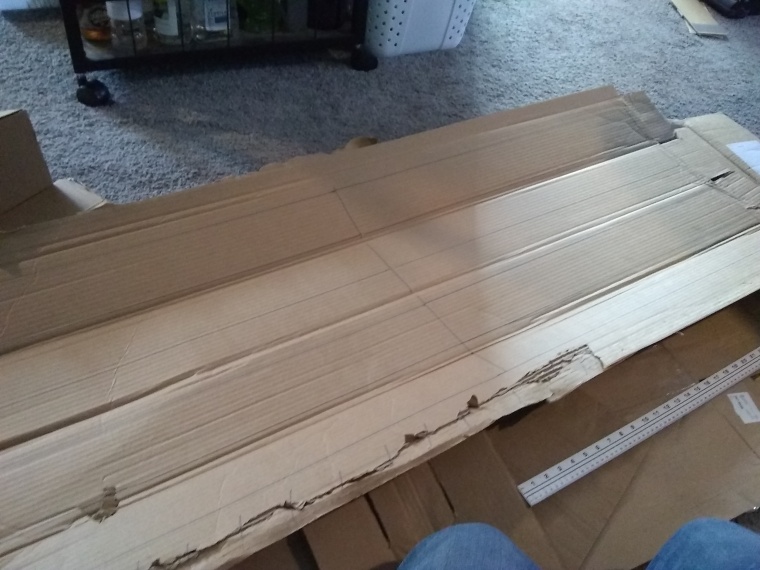 This piece looks like "Grade C" to me.
This piece looks like "Grade C" to me.
 With the layers sliced into thin strips, I'm ready to glue them together.
With the layers sliced into thin strips, I'm ready to glue them together.
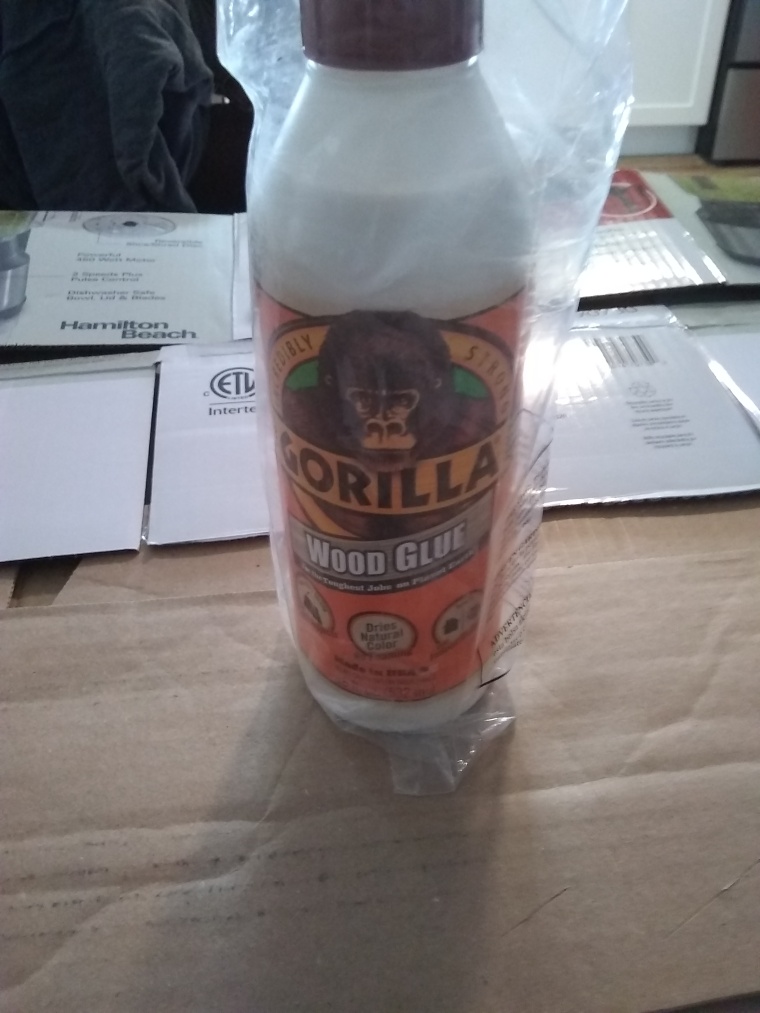 This is wood glue. Is this the right type of glue? I imagine so, though something cheaper might work just as well. Obviously not a super-scientific trial here.
This is wood glue. Is this the right type of glue? I imagine so, though something cheaper might work just as well. Obviously not a super-scientific trial here.
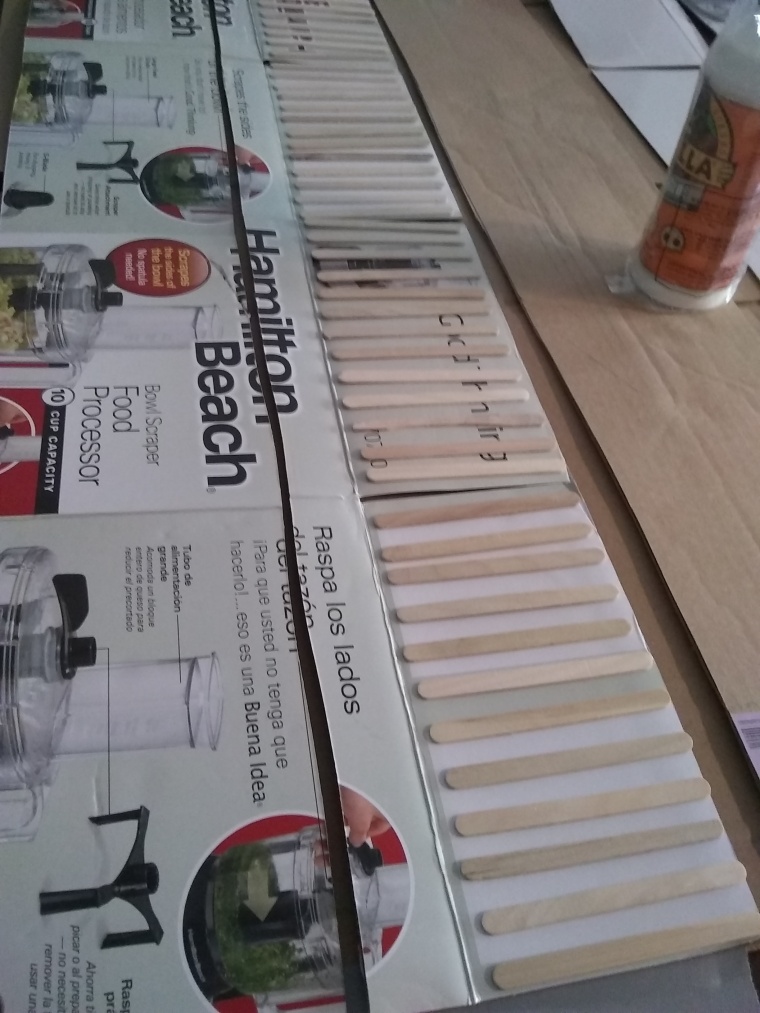 Any good composite needs alternating layers, and I'm alternating with popsicle sticks. Not pictured here is how the alignment differs by 90 degrees: so the total layers of this plycard sample are: outer cardboard, horizontal popsicle sticks, inner cardboard, vertical popsicle sticks, outer cardboard.
Any good composite needs alternating layers, and I'm alternating with popsicle sticks. Not pictured here is how the alignment differs by 90 degrees: so the total layers of this plycard sample are: outer cardboard, horizontal popsicle sticks, inner cardboard, vertical popsicle sticks, outer cardboard.
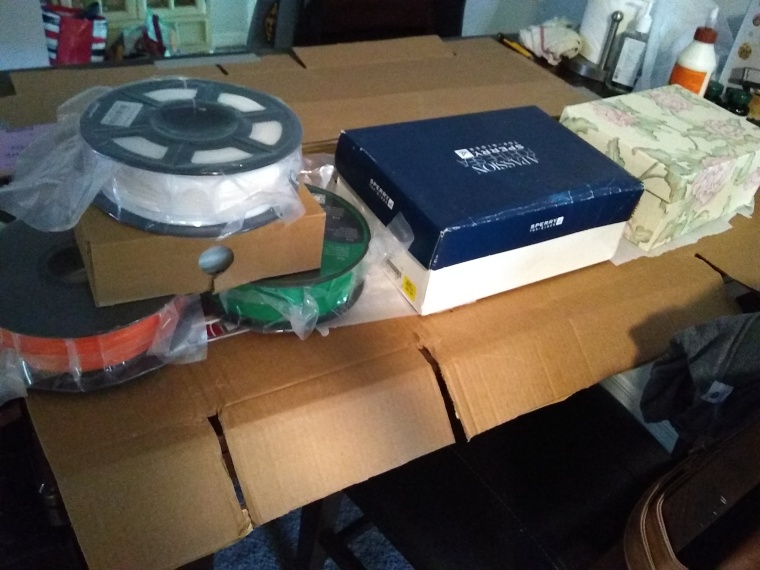 These random items were used to weigh down the plycard while the glue dried. This is our dining room table; yes, my wife is extremely accommodating.
These random items were used to weigh down the plycard while the glue dried. This is our dining room table; yes, my wife is extremely accommodating.
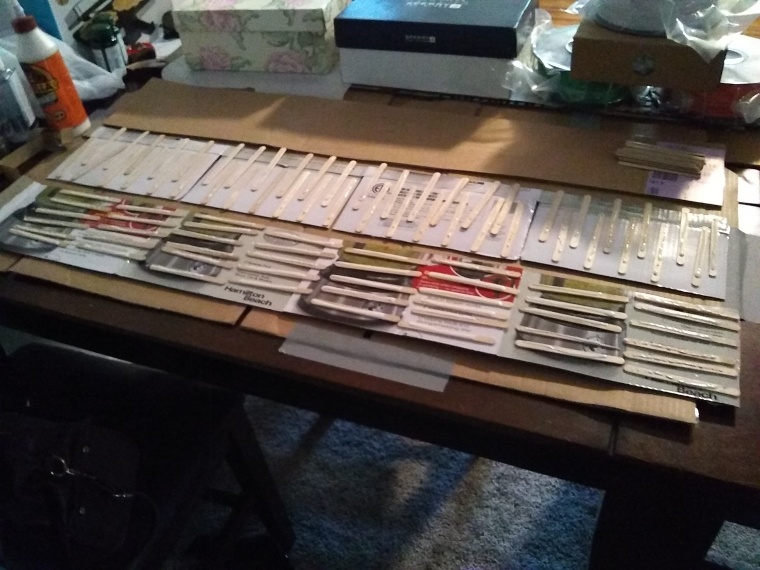 The alternating alignment of popsicle sticks shown here.
The alternating alignment of popsicle sticks shown here.
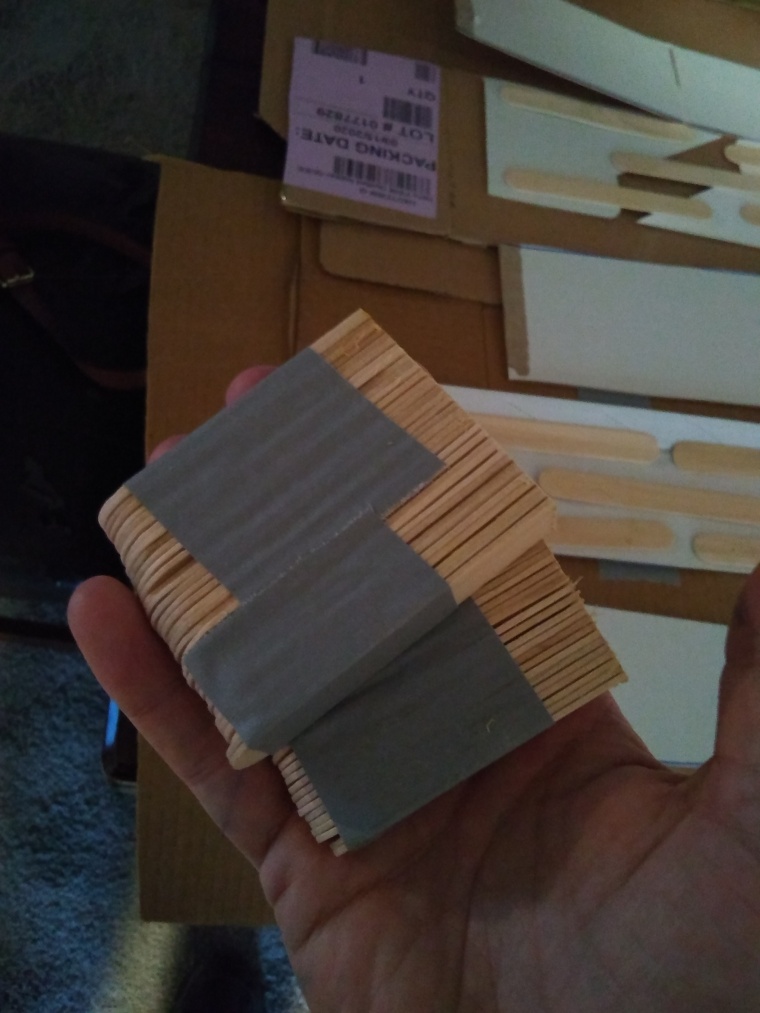 I needed some shorter sections of popsicle sticks, so I wrapped them in tape and used a hacksaw to make two tidy piles.
I needed some shorter sections of popsicle sticks, so I wrapped them in tape and used a hacksaw to make two tidy piles.
This is probably the first picture that shows the next variable: popsicle sticks come in small and large.
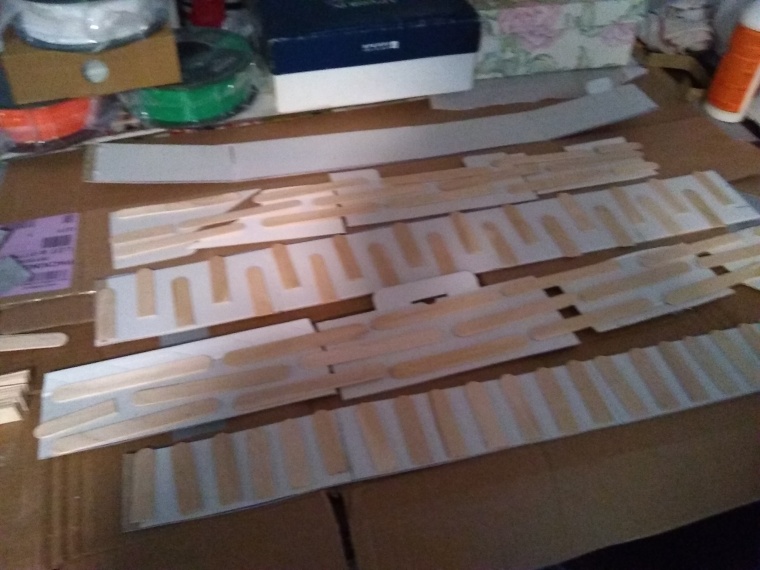 This is a similar view of the layers of plycard, but with large popsicle sticks instead.
This is a similar view of the layers of plycard, but with large popsicle sticks instead.
 Many layers a fine composite make.
Many layers a fine composite make.
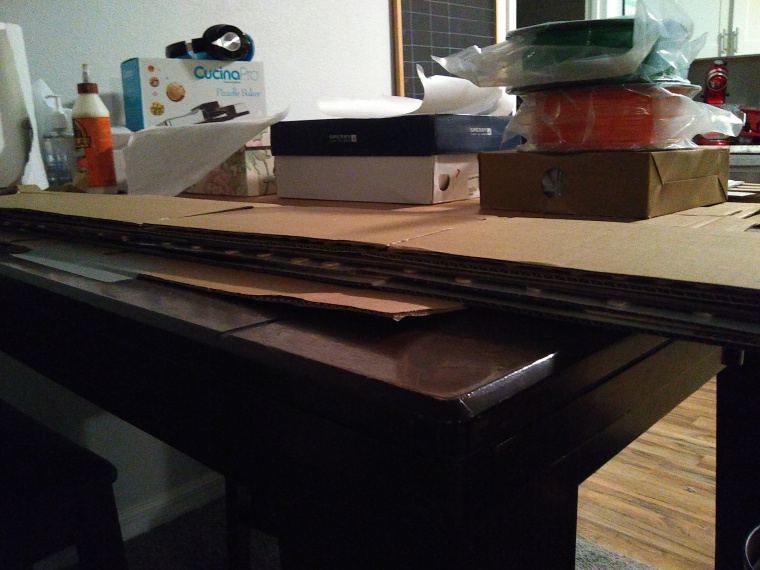 Here's a test panel all glued up. It's quite thick, and there's actually a lot of air inside. The popsicle stick spacing or "density" is yet another variable to configure.
Here's a test panel all glued up. It's quite thick, and there's actually a lot of air inside. The popsicle stick spacing or "density" is yet another variable to configure.
 This is a test cut made with a hand saw. The vibration from using hand tools caused a lot of splitting between the layers, but I was able to get through the popsicle sticks with some effort.
This is a test cut made with a hand saw. The vibration from using hand tools caused a lot of splitting between the layers, but I was able to get through the popsicle sticks with some effort.
Challenges and Setbacks
Many variables, limited test equipment, and lack of vocabulary to even define the problems involved. The resulting sample pieces seemed lightweight and rigid, but I didn't do any quantitative testing.
I'd love to talk to a mechanical engineer about this concept to get my head around it a bit more. Making the space to do more tests, both on the scrap cardboard inputs and the plycard outputs would help.
Favorite Part
The potential. In a world of telework and COVID protocols, a lot more stuff is arriving to my house via cardboard. With a 3D printer, I'm just missing the single board computer and the motors to turn cardboard garbage into mail order golems.
What I Learned
I learned something inconclusive about my limitations, time constraints, and attention span. I managed to get interested enough to order two giant boxes of popsicle sticks and some wood glue, but drying time, the space required to press the boards overnight, and the time to rummage through and rough-size cardboard really sapped my energy for continuing this project.
Any Future Potential?
I don't have the background knowledge to effectively move this idea forward. I may dabble a bit more anyway, though, because I may use plycard instead of wood for cases on a robot. I bet it'll be waterproof enough with a few layers of the right kind of spray primer/paint.
If I come across cheap glue or resin, I may just fill the volume between the popsicle sticks, and reduce the layers. With cardboard only on the outside and cheap popsicle sticks using up lots of volume on the inside, this still might come out as an interesting and low-cost composite material.
This article is a backblog, in which I use a template generation script to turn folders of images into a quick and dirty showcase of something I spent my time on.